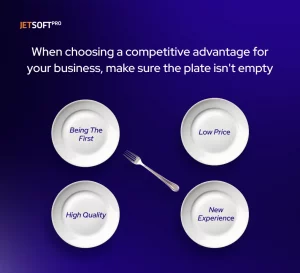On the path to developing your startup, you will inevitably come across the “Sales Strategy” station, and it’s better for your train to stay there until you formulate a truly significant competitive advantage. This is especially important for technology startups because technology is complex. Users often don’t understand it and many are only willing to perceive technology on a superficial level, at the level of obvious practical benefits. For example, you might use completely new materials for a processor that change the game by increasing processing speed and reducing energy consumption. But no matter how innovative this technology is, if your users are not enthusiastic physicists keeping up with technological advances, you will have to come up with something simpler to sell your device. For example, you might frame your competitive advantage as: “Download a movie from the internet in 1 second.” In this blog post, we discuss how to find (or create from scratch) a truly effective competitive advantage for your technology startup.
What is a Competitive Advantage in the Context of Technology Startups?
A competitive advantage is a fact (an accomplished event or phenomenon that truly exists in reality) that sets your product apart from its direct and indirect competitors and allows you to achieve a stable market position and convince a segment of your audience to buy from you. For example, this could be a consistently low price (over the years, not a promotional price), higher product quality, unique and useful product features, or significant ease of use.
The main purpose of a competitive advantage is to ensure the long-term success of a company in the market.
Once you have developed and stabilized your competitive advantage, you should build your unique selling proposition and overall marketing strategy for your product around it.
When it comes to technology, achieving a competitive advantage is challenging because technological development generally provides companies with equal opportunities. Unless you have created a fundamentally new technology, which requires enormous investments, you will need to focus on advantages through additional processes rather than the technologies themselves. In other words, your playing field includes things like quality of support, greater ease of use, reduced user time investment, and unique user experiences (a tactic actively used by Apple).
Read: Lean software development principles
“Popular” Competitive Advantages and What They Mean for Technology Startups
Since the choice of competitive advantages for technology startups is limited, many companies follow similar paths and choose popular advantages. Let’s break them down in detail.
Being the First at Something
Being the first is attractive, but this advantage is highly unstable unless the primacy is historical. For example, if you are the first to invent a fundamentally new device, then being first is a decent option. But if you are first in sales volume in the U.S., your competitor, who holds the number two position in the market, will constantly nip at your heels, and if they ever overtake you, all your previous marketing will be undermined.
Low Prices
This is a universal option because who likes overpaying? However, a low price as a competitive advantage also has low stability, as your competitors will always have the chance to make their products cheaper.
High Quality
High product quality by itself is an excellent competitive advantage, but the nuance lies in what exactly you mean by this concept. For customers, “high quality” often sets unrealistic expectations. For example, buyers might assume that a high-quality device will work for 20 years without repairs or maintenance. If you choose the path of quality, you need to specify your promises; otherwise, you risk damaging your reputation.
New Experiences
This is a path either for geniuses or the desperate. Many companies struggle to clearly frame their competitive advantage because they don’t have one, and they aren’t willing to invest in its development, so they talk about some kind of unique user experience. But experience is a very individual thing, and if your product cannot back up this promise with convenience, quality, and innovation that truly provide a new experience for most users, your competitive advantage will quickly lose its weight.

Read: 9 Software Startup Ideas For Your Business in 2025
How to Define Your Competitive Advantage and When Is the Right Time to Do It?
This should be done at the business planning stage, that is, at the idea stage, because a competitive advantage, especially for technology products, requires organizing processes in such a way that it is constantly maintained. But the world is not perfect, and you might start defining your competitive advantage when your business is already running. In this case, you need to incorporate existing processes into the formula to understand how to modify them with minimal effort.
To determine your competitive advantage, you need to analyze the market, understand the strengths of your competitors, and why users buy from them. The right way to do this is through direct user surveys and product testing. Once you’ve completed this stage, you need to find a niche — a problem of your audience that your competitors haven’t yet solved. This can be something big or small, but it’s better if it’s big, because small advantages are easy to surpass. For example, if you are planning to release a new model of a voice assistant, and after analyzing the market, you realize that users enjoy joking with always-calm assistants and interacting with them to avoid feeling lonely. Here, you might hypothesize that an assistant with a more vibrant personality would help lonely people engage more. This is a problem that can be solved with a small change or a big one. A small change would be adding personality traits to your assistant’s program using existing generative AI models. This will give you a competitive advantage, but its stability is questionable, as other market players can quickly replicate it. On the other hand, you could invest in developing the social skills of the assistant based on information it receives from its conversation partner, so that the assistant’s personality evolves with changes in the user’s life. This would require more investment but would stabilize your competitive advantage.
List of Questions to Determine the Competitive Advantage for a Technology Company
Questions about the Product and Technology:
- What is the uniqueness of your product or technology?
- What specific customer problems does your product solve?
- What innovative features or technologies does your product use?
- What patents or other forms of intellectual property protection do you have?
- How does your product differ from similar solutions on the market (in terms of price, quality, functionality, etc.)?
Questions about the Market and Competitors:
- Who are your main competitors, and what are their strengths and weaknesses?
- What market gaps or unmet needs exist in your industry?
- How can you offer something that your competitors cannot (or will not) offer?
- What market trends could affect your product and strategy?
Questions about Customers and Target Audience:
- Who is your target audience, and what are their needs and preferences?
- Why do or will customers choose you over competitors?
- What product features are most valuable to your customers?
- What aspects of interaction with your product matter most to customers (e.g., ease of use, support, speed)?
Questions about Business and Strategy:
- What resources and competencies set you apart from competitors?
- What strategic partnerships or alliances do you have that give you an advantage?
- What costs can you reduce to offer a more competitive price?
- In which areas of your business are you most flexible and able to adapt quickly to changes?
Questions about Brand and Reputation:
- What reputation does your brand have in the market?
- How can you use customer loyalty to promote your product?
- How is your brand perceived in comparison to competitors (e.g., innovation, reliability, quality)?
Questions about Scaling and Network Effects:
- Can you scale your product or business model faster than competitors?
- Are there network effects that make your product more valuable as the user base grows?
- How can creating an ecosystem around your product enhance your competitive advantage?
These questions will help you thoroughly assess your market position and identify your competitive advantage. The answers will give you a clearer understanding of how best to differentiate your product or service from the competition.
By the way, if you need help defining a competitive advantage for your technology product, the marketing experts at JetSoftPro are always ready to help.

